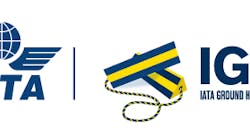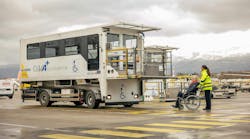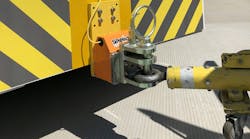The 31 says it all. The IATA Ground Handling Conference (IGHC) is the longest continuous running ground handling conference in the world, and has been called the premium ground handling event.
This year’s conference will be held at the Sheraton Grand Doha Resort and Convention Hotel in Doha, Qatar, April 22 through April 25.
This is not only the opportunity for the worlds’ airlines and ground handlers’ key decision-makers to meet and network, it is also the place where they – together with their peers in the entire ground handling industry value chain – can discuss and strategize about pressing issues and developments in ground handling. Typically the IGHC attracts 700 plus delegates from more than 80 different counties with a wide spread of experience and opinion.
Traditional ground handling is going to change dramatically in the coming years: conceive the vision and accept the challenge.
For 2018, IATA is taking a look into the future of ground operations. This is not just from the perspective of the traditional ground handling operations, but also the things which affect ground operations and the things which ground operations affect – like airports, the terminals, the aircraft and the ramp.
On Wednesday, April 25, the IGHC plenary session will be looking into two key priorities of IATA.
One of these priorities is the NEXTT initiative, which pulls together a common vision to enhance the on-ground transport experience. It examines how the latest technology developments and innovations can be used to improve the journey for passenger, baggage, cargo and the aircraft turnaround. Anyone who is involved in the airline industry will be interested to know what the airframers, airports as well as ramp and terminal experts are anticipating for the future.
Trends to push processes off-airport, deployment of more advanced technologies and automation will lead to a rapid transformation and modernization of ground handling. This technology already has the potential to deliver efficiencies that are otherwise unachievable. But, this demands real-time, trusted, reliable data exchanges to make interactive decisions.
Sessions on GSE pooling and autonomous/self-docking GSE will share practical experience on these topics.
The passengers’ journey – from booking the ticket, until arrival at a final destination or return to home, is increasingly in the spotlight as concerns for increased security measures and checks vie with more and more passenger numbers through the airports and into the transport feeder networks that serve the airport.
Digitization of the entire airport and its peripherals covered in the NEXTT initiative will be covered from the airport and ramp perspective. The aim is to make the entire process, as seen from airline’s primary clients’ point of view (the passenger), seamless, secure and efficient.
While the traditional aircraft “tube, wings and tail” shapes will be with us for quite a number of years yet, there are good chances that this could change in the longer term as potential use of blended wings and other radical thinking about aircraft structure and power sources take shape.
Changing the shape of the aircraft will likely change the shape of the terminal because of how these differently shaped aircraft “plug in” – literally and figuratively – to the airport terminals.
Passenger boarding bridges, passenger stairs, cargo loaders and all the current host of GSE are all based on docking equipment at a more-or-less circular cross-sectioned fuselage. Moving to a radically different shape of aircraft means re-thinking how to load and unload passengers, baggage, cargo, and food and, possibly to a lesser extent, how to deal with power, fuel, water and waste. This means re-thinking GSE and ramp operations and even ramp and aircraft parking capacity.
Shifting from traditional fuel sources, both for future aircraft and future GSE, brings with it a potentially different airport terminal building design so that, for example, maximum electrical energy generation can be achieved by harvesting power from optimally orientated solar panels and even wind generators that could form an integral part of airport building design to augment the hugely increased demand for electrical power to support an all-electric aircraft and ground service vehicle fleet in addition to the already large load of current buildings.
These airport terminal structural and passenger embarking/disembarking changes are but one facet of the changes coming to passengers as we look into the future. How all this is to be done will be the focus of the Passenger Journey session on Wednesday – looking into the whole passenger experience.
Another piece of the digitization/integration puzzle is tackled in a workshop on efficient load control. Currently, there are a lot of manual processes and heavy reliance on manually noted and transferred information.
IATA’s LCAM group is focusing on this aspect and looking into ways in which consistency and standardization together with shared platforms can not only eliminate the errors inherent in the manual systems, but which will enhance the system capability by being able to incorporate updates, recalculate loads/capacity depending on cargo loading system lock/stop serviceability, fuel, water needs and more – all in real-time.
What really sets this event apart and makes it unique, is that IATA backs its event with a solid foundation of ground handling expertise, or access to necessary expertise, which can be brought to bear on pretty much any aspect of the ramp and transfer that to industry standards and initiatives.
In addition, with its publications and manuals, IATA has a very effective means of shaping and making actual change in the industry. Behind the scenes at IATA Ground Operations, there is a structure of a Ground Operations Working Group (the GOG) and five Technical Groups (TGs) comprising experts from airlines, ground service providers, manufacturers and solutions providers who all actively contribute their time and experience to ensure that what is found in the Airport Handling Manual (AHM), the IATA Ground Operations Manual (IGOM), the Load Control XML Toolkit and the new Weight & Balance Information Centre will be applicable, relevant and up to date with the industry.
There will be opportunities to meet with and hear from members of the GOG as well as the TGs through either plenary sessions or workshops.
Furthermore, it is the IGHC where IATA both prompts and listens to the industry.
It was at the IGHC in Kuala Lumpur in 2014 where the idea of standardized machine readable aircraft alignment markings was mooted and surveyed amongst the participants, together with the concept of engineering out the risk in GSE. This has resulted in new requirements for GSE in the AHM and prototype autonomous GSE that are already docking safely at the aircraft.
In a similar fashion, there are the introduction of the IGOM, the move to a XML format for Load Control and the encouragement and interest received for the weight and balance information center, which owe their existence either in whole or in part to the IGHC.
Not to be forgotten, is the perennial favorite of the IGHC – the IATA Standard Ground Handling Agreement (SGHA). The SGHA is in fact what launched the IGHC all those years ago with the need to create a forum at which airlines and ground service providers could meet on equal terms to discuss the nuts and bolts of contracting out ground handling. This document has become the de facto industry ground handling agreement, and it is at the IGHC where IATA and the members of the AGSA Technical Group receives useful input and feedback on the SGHA.
This year the conference will also tackle the changes in the SGHA 2018 published this year, enabling delegates to understand new provisions such as airlines insolvency, cargo damage liability and many others.
All the above clearly provide tangible, practical evidence of the positive influence that the IGHC can have on the industry. There are, of course also the great locations, the overall well-balanced set of plenary sessions, workshops and networking opportunities, and the IGHC Innovator competition – introduced last year, which IATA expects to be tightly contested again for the best ground handling industry ideas.
In addition there is the exhibition, welcome cocktail and gala networking reception, topped off with professional event management by an experienced team to make the IGHC not only the longest running, but also the most wide-ranging ground handling event – with the unique ability to produce and sustain real change and benefits in the industry.
This article was provided by IATA Ground Operations







